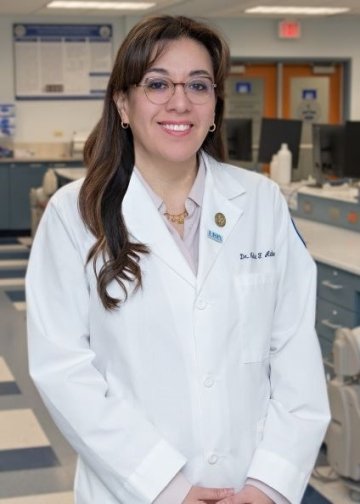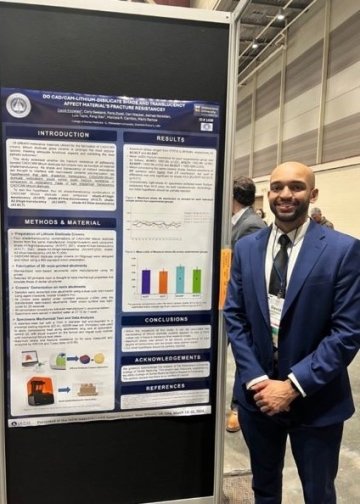
“I think the most rewarding aspect of my job is creating communities of research and practice that collectively offer students, faculty, patients, and families a supportive space to connect and learn in ways that are personally meaningful.”
Research Interests:
I have several different research interests, including visual attention to complex and social information in neurodiverse populations, group literacy intervention dynamics, and evidence-based practice.
Years at Midwestern:
I have been at Midwestern University for six and a half years.
What is the most rewarding part of being a member of the Midwestern University faculty?:
I think the most rewarding aspect of my job is creating communities of research and practice that collectively offer students, faculty, patients, and families a supportive space to connect and learn in ways that are personally meaningful. Learning is a profoundly social behavior, so by creating the communities that foster social connection and a sense of belonging to a group, personal growth and learning can’t help but occur. For example, one community of practice I’ve started is Family Literacy Night, a family-centered reading event held once a month at the Foothills Library for local parents and their young children who are learning to read. MWU students connect with faculty and each other to prepare. At the event, families find community with students who engage families in shared reading strategies that foster child literacy development. Through this experience, everyone involved comes away with a learning, and the social nature of the event provides the motivation to keep coming and keep learning.
I also use community to teach through my translational adapted group (TAG) research lab, which ultimately seeks to clarify the nebulous intersection of two noncommutative approaches: research and practice. Because my own professional experiences were first clinical and only later involved research training, I’ve observed that the research-practice gap is really a socially constructed divide. So, I use social communities to bridge this gap. It’s pretty powerful when it works, and students or faculty who come in without research training begin to see that research is simply a set of tools that help us think systematically and solve problems. When students, staff, and faculty are given the agency and authority to access and use research tools, they are empowered to read research, practice systematically, and create their own communities of research and practice when they leave us.
How do you engage students in the learning process?:
I approach teaching through an applied, practice-oriented lens. I think every instructor has observed students who appear to grasp course content during didactic lecture, only to realize later that they’ve forgotten what we talked about. Because I’m a clinician, I’ve always been interested in how learning happens through the iterative interactions of a learner with their environment - in this case, the interactions of my teaching methods with student learning outcomes. After some trial, error, self-reflection, and improvement, I’ve pulled together a framework that promotes greater depth of student knowledge that transfers from classroom to clinic. I’ve restructured all my courses according to an instructional routine I’m calling: Concept – component – application – practice (CcAP). Concept (big “C”) and component (little “c”) represent the big-picture categories and the details that map onto these categories; I teach students this structure and highlight big “C” and little “c” on my lecture slides. Structuring lectures in this way helps students offload the cognitive resources needed to understand my expectations for course content, allowing them to deploy these resources towards developing their own frameworks of knowledge.
Throughout lecture, I provide “application” breaks, where students are given some independent/small group time to think about how the framework we’ve just learned about applies to a past or future experience. This integrative process of connecting new knowledge to student experiences helps them see and reflect on how they might use what they’ve learned in the real world. Finally, students participate in learning labs, where they get to practice and receive feedback on the concepts and skills they’ve learned about. I utilize several different methods to offer practice opportunities, including use of our simulation center. I’ve found that students really need tangible, “hands-on” experiences to both retain and transfer academic course content. When clinical faculty share that they’ve noticed students saying or doing things we’ve practiced in class, that’s when I know real learning is happening.
What do you hope students learn from your classes?:
Because MWU operates on a quarter schedule, 10 weeks to learn about anything is a knowledge sprint. Coming from a semester system, this has forced me (in a good way) to narrow my courses down to the most essential, foundational elements, and to align the content I teach sequentially across courses. By doing so, I hope that students come out of my classes with a deep understanding of foundational elements, but also strategies to continue their learning in the practice context they end up in. I also spend a fair amount of time teaching students about the neuroscience of their own learning processes and barriers and facilitators of learning. This allows students to explore what they need to learn and grow. I always tell students that the best clinicians are not the most knowledgeable, skilled, or well-known; they are the most reflective. By offering regular opportunities for self-reflection, I hope that students come out of each class knowing a little bit more about themselves.
Why should students enroll at Midwestern University?:
When I’m interviewing graduate candidates for admission, I always come back to the following points as reasons that students should enroll at Midwestern University: 1) we are student-centered and graduate only. This means that the faculty are fully committed to your success and wellbeing while you are with us; in both tough times and in your small daily victories, we will be there for you. 2) Our faculty are translational, many with robust, real-world clinical experiences and research training; this means that your classes and clinical experiences will be translational, supporting your ability make connections between research and clinic in ways that elevate your professional practice. 3) There are myriad opportunities for you to get involved in a practice or research community outside of class and clinic by participating in faculty research or clinical labs, many of which are interprofessional. These opportunities allow you to take on unique professional roles, such as advocacy, that contribute meaningfully to our community and profession.
What lessons would you like students to take with them in their professional careers?:
In my interactions with students, I do my best to model the sort of individualized and supportive leadership that I value. If we expect that our students will eventually become leaders in their chosen profession, and I do, I want them to be the sort of social, healthcare leaders that connect people and lift others up. President Kennedy was talking about the economy when he said, “A rising tide lifts all boats”, but the quote is relevant here: I want our students to be part of that rising tide. While it’s not always perfect, I and our faculty regularly set intentions to model transparency, humility, courage, advocacy, persistence, critical thinking, universal design (for *everything*), care-work, community, and discovery in all our interactions with students. I hope that students graduating from Midwestern University use these models to not only grow their clinical expertise, but also their good human and leadership skills.



